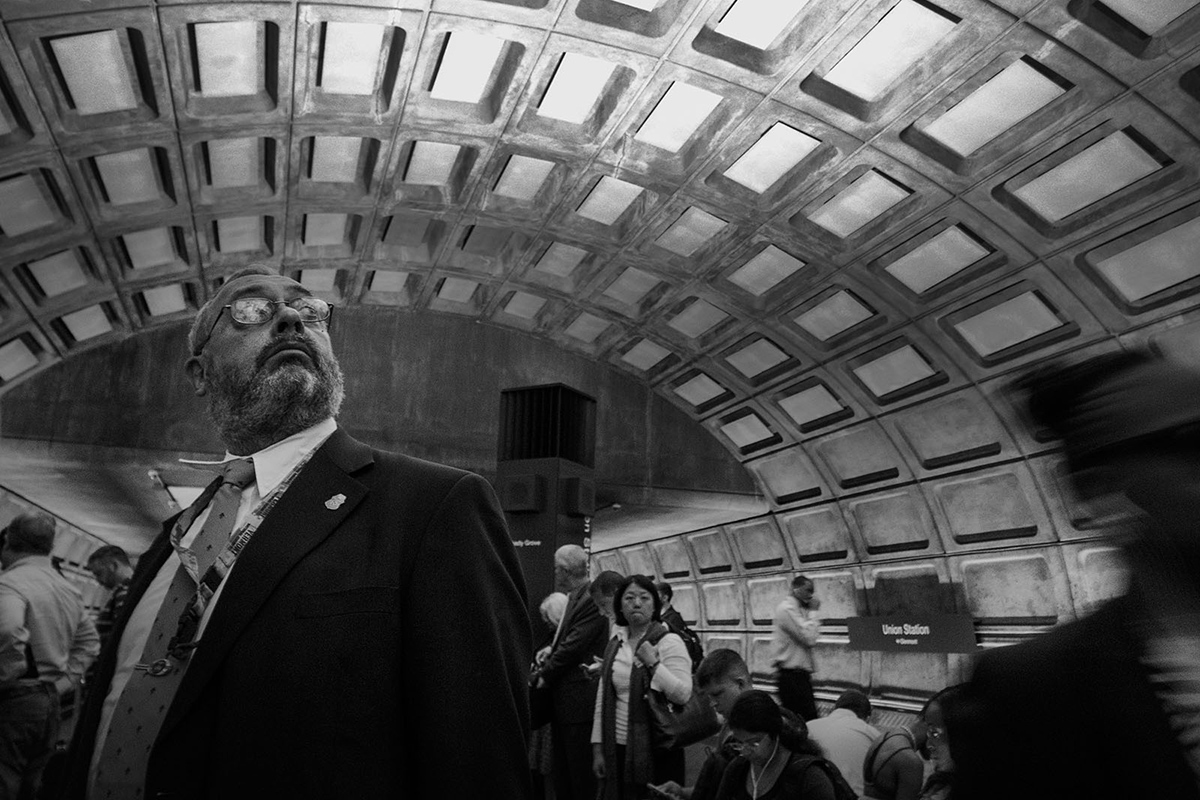Between 1938 and 1941, Walker Evans, one of the foremost photographers of the twentieth century, surreptitiously took more than 600 photographs of ordinary people traveling on New York City subway trains. One reason Evans sought the subway was the diversity of riders—presenting to the photographer “such an intense and various concentration of human beings as the world has never known before” (in the words of James Agee, who often collaborated with Evans). Another reason was that subway riders were exposed; “The guard is down and the mask is off,” Evans observed—which is why he equipped himself with a hidden portable camera, its lens aligned with an open buttonhole on his overcoat, and snapped away. The results show many people seemingly lost in private thoughts that we today can only imagine. No one is staring at a handheld mobile device.
Nearly seventy years later, Hugh Talman, a staff photographer at the Smithsonian’s National Museum of American History since 1987, began taking photographs of commuters as part of his daily ride from Manassas, Virginia, traveling on the Virginia Railway Express and the Washington Metro. Talman doesn’t hide his compact camera beneath his jacket like Evans, but he also doesn’t want to make it obvious that he is photographing his fellow passengers.
Holding the camera close to his chest, Talman uses one of the knuckles on his left hand to aim the lens. “The camera is totally silent,” Talman explained. “I once took fourteen shots of a woman putting on her makeup, and she never knew it.”

On a typical day, Talman may take between 150 and 200 images but will save only six or seven of them. Of the tens of thousands of digital photographs he has taken on VRE and Metro over seven years, there are perhaps only 3,000 that he feels are “acceptable.” He is seeking what Henri Cartier-Bresson called “the decisive moment,” which may be fleeting and ephemeral, but which captures the essence of that instant. For Talman, the decisive moment “could be a gesture, a coffee cup, a hat, or a shaft of light coming through the train station in a certain way.”
Talman’s guiding principle is to be respectful of people. “I really appreciate them. I appreciate their form, their movement, and their emotions.”
“The Metro pictures are a type of therapy for me,” Talman confided while sharing with me a small sample of his photographs on a computer screen. “My day job is that I’m a studio photographer, and studio photography is all very precise—lighting, fiddling with this and that and everything to get it to look beautiful, and so on and so forth. It is very tedious and very OCD. So, photography on the Metro is something very different. Life comes at you really quick.”
Take, for instance, the photo of a man standing on a Metro platform.

“This is one I kept trying to get and trying to get, and it may be the only one I’ll ever get,” Talman recalled. “There’s a guy standing on a platform and the train is coming in; the challenge is to get the stillness of him on the platform with the motion of the train just before it gets to him.”
The image appears almost bifurcated: on the left, the beigeness of Metro’s raw concrete; on the right, the train speeding by, its red lights appearing as if time-lapsed, while in the center the man with earphones stands still, totally absorbed by the screen in his hand.
Another of those decisive moments highlights a similar type of absorption, almost comical, of a baby, snuggled against its mother but craning its neck to see what’s on her cell phone.

“Afterwards, you can try and conceptualize the photograph—you know, the prevalence of iPhone culture and all that—but in that moment, I just saw the baby looking at the phone.”
Conceptualizing photographs is something that comes naturally to Talman, who studied at the Rhode Island School of Design, under the tutelage of legendary photographers Harry Callahan and Aaron Siskind. After graduation, Talman worked twelve years as a photographer and darkroom technician at the National Archives, where he carefully handled glass plates from the Civil War and negatives from many of the great photographers with the Farm Security Administration in the 1930s and 1940s. Being so well versed in the history of art and photography, Talman could not help but think of the painter René Magritte when he snapped this photo of a man in a bowler hat at a Metro farecard machine.

Artistic aesthetics aside, what motivates Talman most is what he calls “the democratization of Metro”—illustrated by the layer of hands sharing one pole in a train car.

“I don’t care if you’re a high-level executive or if you’re a laborer. We all get on the Metro to get to the job,” he observed. “This is what we’re like in the morning. We’re tired. Our makeup isn’t quite right, or our ties aren’t yet tied.”


Talman understands why many of his fellow commuters just want to read the newspaper or stare at their cell phones.


“They don’t want to be bothered. But sometimes I want to tell them, if you guys would just look up, imagine what you’d see: our common humanity, all on the train.”
James Deutsch is a program curator at the Center for Folklife and Cultural Heritage. In 1977, he worked as a photographer and reporter for the Peoples’ Press in Yazoo City, Mississippi, where there were neither subways nor commuter trains.


